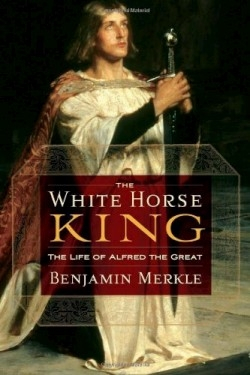It looks like you've stumbled upon a page meant to be read by our code instead of viewed directly. You're probably looking for this page.
The White Horse King
The Life of Alfred the Great
Lindisfarne Island, just off Great Britan’s northeast coast, was the site of a turning point in Anglo-Saxon history. A monastery founded there survived nearly 160 years until “heathen men miserably devastated [it] by plunder and slaughter.” That year, AD 793, marked the beginning of the reign of terror of the Vikings over the Anglo-Saxon people.
Such is the constant backstory to the life and eventual reign of Alfred (born AD 849), fifth and youngest son of Ethelwulf, King of Wessex, when England was comprised of several Anglo-Saxon nations. Two of his most famous battles were fought where the image of a large white horse had been carved into the hillside—hence his nickname.
This is a true-life adventure and Merkle, a doctoral candidate at the University of Oxford, and a Fellow of Theology and Classical Languages at New Saint Andrews College, is a wonderful storyteller. Readers will have little difficulty following the journey of the only king with the sobriquet “the great” attached to his name, and discovering exactly why. Alfred’s insights and accomplishments were many, in the fields of education, law, military science, and religion.
The book also succeeds as the history of a specific time period. The author is quick to explain unfamiliar vocabulary. For example, much is made of the relative strength of one of the era’s military structures, known as the fyrd, a voluntary ad hoc militia. Readers learn of the via francigena, the well-traveled route leading pilgrims to Rome (where Alfred was sent for a visit at age four) and the shield wall, which “consisted simply of a line of men standing shoulder to shoulder with their shields overlapping one another, forming a continuous wall of protection,” an already ancient battle tactic in 871.
A brief genealogy in the form of a “Cast of Characters,” and a chronology listing key dates in Anglo-Saxon history from AD 410 to AD 937 offer additional background information. History buffs not familiar with this ear will enjoy this introduction.
Because he established new ways for his countrymen to compete in warfare and reestablished the defenses of Great Britain, the Vikings were driven away completely within forty years of Alfred’s death. He also revived the then-dying art of literacy. He was truly “a king who gave himself for his people.”
Disclosure: This article is not an endorsement, but a review. The publisher of this book provided free copies of the book to have their book reviewed by a professional reviewer. No fee was paid by the publisher for this review. Foreword Reviews only recommends books that we love. Foreword Magazine, Inc. is disclosing this in accordance with the Federal Trade Commission’s 16 CFR, Part 255.
